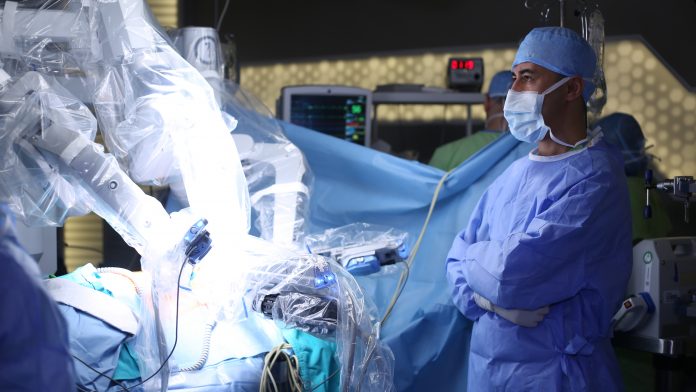The healthcare sector is constantly changing, and many practices have been modified to become more efficient: So how can technology help with advancing surgeries?
In line with the continuous development of new systems, medical operations look set to change and become more technologically-led. Keyhole surgery was once a revelation that shook the healthcare sector, but we’ve moved on a lot since then. Join Acorn Stairlifts and take a look at some of the technologies which are leading the industry forward.
Robotic surgery
Demonstrating the impressive ability of technology, robotic surgery has already been used in many minimally invasive operations, helping to make procedures more precise and less time-consuming. One of the world’s most advanced surgical robot — the da Vinci Si, offers surgeons the ability to perform surgeries using a 3D camera, guiding them through the procedure. Surgeons use exterior controls to direct the robot, which reduces the effects of fatigue on the ability to maintain precision throughout.
This is an extremely advanced technology, and it can be used to enhance a variety of complex operations. As well as enhancing accuracy, medical robots are also safer and more hygienic, utilizing pinpoint precision and interacting with recognized algorithms and artificial intelligence. Patients will be able to enjoy less bodily trauma, minimal scarring and a faster recovery time, all under the capable hands of a robot-surgeon.
Robots will have a place in healthcare beyond the surgeons’ table though, as they can be used to help disinfect hospital rooms, which reduces the risk of any bacteria lingering around.
Genomics
In 2018, the government of Canada confirmed that a staggering $255 million investment into genomics has been made, giving hope to those living with juvenile arthritis, childhood asthma, cystic fibrosis and even cancer. Genomics involves analysis of individual DNA, aiming to identify and predict those who are more likely to develop a certain illness.
The Honourable Kirsty Duncan, Minister of Science said: “It is an honour to support some of Canada’s leading genomics and precision health researchers through investments that will allow them to further their discoveries and innovations”, emphasizing the potential for further progress.
Preventative surgeries could be performed at an earlier stage using genomic intelligence, with procedures such as blood tests becoming vital in liquid DNA analysis, which then goes on to identify any conditions prior to any symptoms in some cases.
Needle-free diabetes care
For those living with diabetes, an American firm is making some impressive advances towards establishing needle-free care for diabetes patients. Currently, those living with the condition need to maintain their blood glucose, which involves drawing blood regularly, as well as administering insulin shots.
As a consequence, those who do administer self-care are at an increased risk of infection, all of which has prompted research into alternative, more sanitary methods. The firm are working towards the development of needle-free systems which allow patients to keep a check on their blood glucose levels, in the form of a patch.
The patch is designed to remove enough top-layer skin cells to determine the blood glucose content, known as a transdermal biosensor. The system will include a device similar to an electric toothbrush, which removes the necessary cells and interprets the blood composition, sending it to a remote monitor where the user can decipher the result. An alert will sound should the patient’s glucose level exceed a manageable amount, providing assurance for the user and speeding up the time required to get it back to the appropriate level.
Preventative advancements in melanoma treatment
Melanoma is notoriously known as the deadliest form of skin cancer, and people are encouraged to look for its early development through abnormal or changes in mole appearances. Invasive biopsies were previously the only way to determine whether or not a mole was dangerous, but now, there could be an alternative on the horizon for the mainstream healthcare sector.
Dermatologists can now utilize a handheld device to help them decide the best course of action. The MelaFind optical scanner does not guarantee verified diagnosis, but it equips doctors and nurses with additional information on any queried moles. By providing analysis of a mole, an unnecessary biopsy can be prevented, or contrarily, it can help to speed up the procedure.
Current goals in the sector are to reduce the number of patients who are left with scar tissues, and the associated cost of these procedures will be lowered as a result. Approximately 80,000 cases of skin cancer are diagnosed in Canada each year, so this innovation could enhance how these cases are dealt with in a timely manner.
The medical sector is embracing a wave of new technologies, all of which can help to improve a patients experience while in hospital. The emergency room is certainly moving in line with the times, as modern healthcare professionals find new, more efficient solutions to both minor and major procedures.
Sources
https://www.asme.org/engineering-topics/articles/bioengineering/top-5-medical-technology-innovations
https://med.nyu.edu/robotic-surgery/physicians/what-robotic-surgery
https://www.newswire.ca/news-releases/canadian-patients-to-benefit-from-major-investment-in-genomics-and-precision-health-research-670701123.html
https://www.ctvnews.ca/health/canadians-among-the-most-susceptible-to-skin-cancer-study-finds-1.4028822











